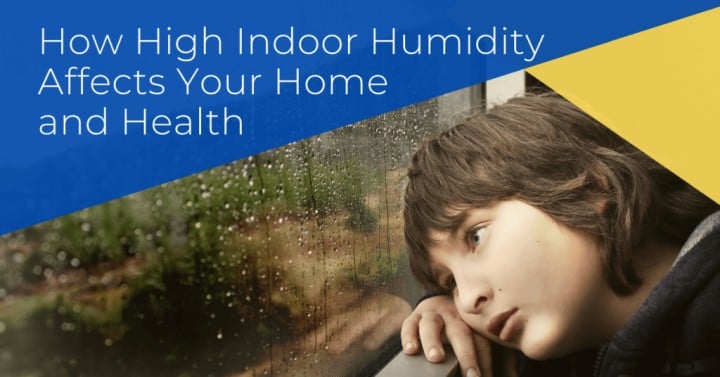
Humidity is the presence of water vapor in the atmosphere. Humidity is measured in either relative humidity (relative terms) or dewpoint temperature (absolute terms). As the name implies, water vapor is water in vapor form. In terms of comfort and health, the ideal relative humidity is 40 to 50 percent. During winter, it may need to be lower than 40 percent to prevent condensation on your windows and other harmful effects of high indoor humidity.
Effects of High Indoor Humidity
On Human Health
High indoor humidity affects the human body by causing a harmful health problem for the elderly and people with respiratory or heart conditions. When the surrounding temperature increases, the body cools down itself through perspiration. However, that cooling mechanism only works if the sweat evaporates. When the relative humidity increases, the evaporation rate decreases. This causes more stress to the circulatory system when it tries to fight the effects of increasing temperature.
The growth of dust mites, mold, and fungi will be triggered if the moisture content in a building is high. These organisms are capable of causing serious reactions in people with asthma or allergies. The air conditioner may circulate these contaminants continuously across the ductwork until inhaled by an occupant.
On Comfort
The instant effect of high indoor humidity is on a person’s comfort. Because of the humid and damp feeling it brings about, you will feel warmer. Imagine this problem taking its toll on you at night, affecting the quality of your sleep. To make yourself feel comfortable, you need to lower your thermostat temperature, which leads to higher electricity bills.
On Residential Building
High indoor humidity problems usually arise during summer as your AC is working regularly. Other serious effects of high indoor humidity are structural damage and mold growth because of wood decomposition. Termites, bugs, and other pests and insects are attracted to places with high moisture content.
How An Air Conditioner Controls Humidity
A central air conditioning system is essential for both home comfort and humidity control. At a high temperature, moist air is absorbed from the living room and drawn all over the evaporator coil throughout the refrigeration cycle, then the vapor is condensed and drained outside. The removed moisture helps decrease the relative humidity, improving the sense of comfort.
A central air conditioning system needs to be sized properly to ensure correct dehumidification. An oversized unit may be unable to function long enough to reduce the humidity to a comfortable level.
To avoid the effects of high indoor humidity, you may consider installing a whole-home dehumidifier directly into your air conditioner to function with the system. When the system absorbs air, the dehumidifier will remove water from the air before it’s circulated into your house. The dehumidifier can achieve the recommended relative humidity based on your thermostat’s temperature setting to achieve the highest level of comfort.
Tips for Lowering Humidity
- Install a central air conditioner
- Install a dehumidifier
- Provide extra venting to high-humidity areas like bathrooms and laundry rooms
- Take cooler showers
- Limit bathing times
- Remove blockages from dryer vents
- Get rid of indoor plants
- Switch off humidifiers
- Install a humidistat
- Put portable dehumidifiers in high-humidity areas.
Other Ways to Lower Humidity Levels
- There are several ways of addressing humidity concerns inside a home. One inexpensive way is using a hygrometer that will measure the relative humidity inside your home. When this device provides a reading, you can use it to compare the humidity of your home to a recommended standard.
- You have to promote good ventilation by simply opening your windows once in a while to allow fresh outdoor air to replace stale indoor air. Also, you must always use your exhaust fans in the kitchen and bathroom. It is a good idea as well to fix moisture issues inside your house by checking for any leaks from the plumbing systems.
- Wet clothes that are hung indoors will raise your indoor humidity, especially in areas with bad ventilation. Drying clothes outdoors is the best option of reducing indoor humidity, especially in humid seasons. If you live in an apartment without a balcony and this process is not feasible, make use of a clothes dryer and vent it outdoors.
- Walls with holes or cracks can also take moisture into your home. Moist and warm outdoor air can enter a building through holes and cracks during humid, warm weather. Indoor materials that are cooler than outdoor air can condensate. This condensation can result in mildew, mold, and rotting wood if not immediately wiped up. Hence, check the exterior walls of your home regularly for any cracks and repair them correctly.
- Using charcoal briquettes is a cheap way of reducing humidity and odors in the air due to their absorption capabilities. Purchase a pack of charcoal and put it into a basket. It will last for two to three months.
We hope you found this blog post on How High Indoor Humidity Affects Your Home and Your Health, useful. Be sure to check out our post on Difference Between Central Air Conditioning & Window Air Conditioner for more great tips!
Have Experience in the Moving Industry? Want an Additional Income Stream? Work With All Around Moving!
Partner with us and we’ll help you make money. Click here to learn more.





